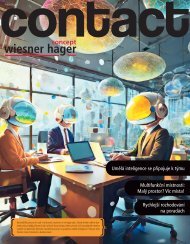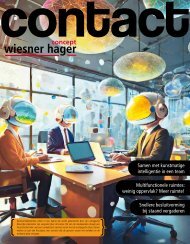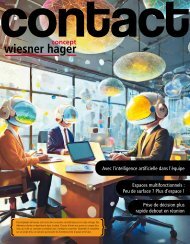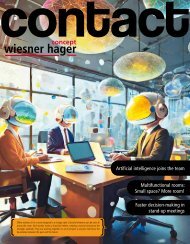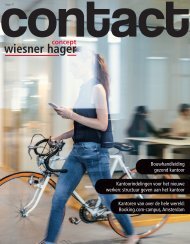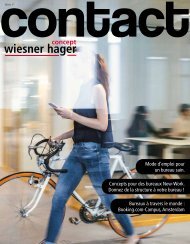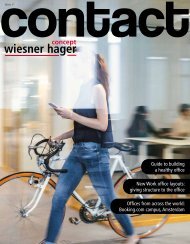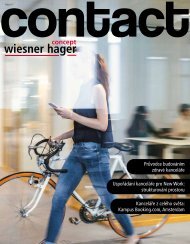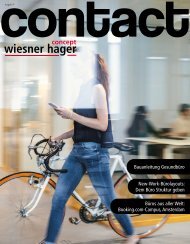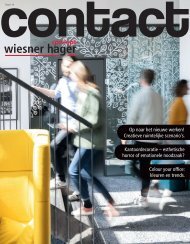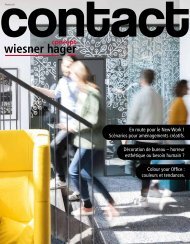contact_magazine_#34_EN
How will we work in the future? The pandemic has reshuffled the cards, and the more we sit at home and work remote, the more important it becomes to find solutions. In the title story we have thought about some constructive ideas about the new profile of requirements for the post-COVID office. And one thing became immediately clear: the emptiness in the office caused by remote work and work at home must be filled again. But how? Apart from this, we visit a cool New Work office above the roofs of Vienna, where the interior architectural concept has provided a new boost to ideas. And we transport you to Amsterdam to a boudoir of clouds and waves. Here the architect’s office Beyond Space has dreamed up an ode to sky and sea: simply fascinating! The journey continues with the red hot topic “Sustainable Office Furniture Trends” and arrives at a clear conclusion: green is in! Furthermore, there are tips on break management, useful ideas for everyday office life, a practical New Work dictionary and a fascinated look at the desk of Murat Özcelik, geneticist, microbiologist and architect all in one.
How will we work in the future? The pandemic has reshuffled the cards, and the more we sit at home and work remote, the more important it becomes to find solutions. In the title story we have thought about some constructive ideas about the new profile of requirements for the post-COVID office. And one thing became immediately clear: the emptiness in the office caused by remote work and work at home must be filled again. But how? Apart from this, we visit a cool New Work office above the roofs of Vienna, where the interior architectural concept has provided a new boost to ideas. And we transport you to Amsterdam to a boudoir of clouds and waves. Here the architect’s office Beyond Space has dreamed up an ode to sky and sea: simply fascinating! The journey continues with the red hot topic “Sustainable Office Furniture Trends” and arrives at a clear conclusion: green is in! Furthermore, there are tips on break management, useful ideas for everyday office life, a practical New Work dictionary and a fascinated look at the desk of Murat Özcelik, geneticist, microbiologist and architect all in one.
You also want an ePaper? Increase the reach of your titles
YUMPU automatically turns print PDFs into web optimized ePapers that Google loves.
Edition 34<br />
Post-pandemic office design.<br />
Reference story: CCE in the Icon Vienna.<br />
Green is in: sustainable office furniture trends.<br />
What’s on your desk, Murat Özcelik?
Question: “Do we have<br />
to redefine the term<br />
office?” Answer: “Yes!”<br />
How will we work in the future? The pandemic has reshuffled the cards,<br />
and the more we sit at home and work remote, the more important it<br />
becomes to find solutions. In the title story we have thought about some<br />
constructive ideas about the new profile of requirements for the post-<br />
COVID office. And one thing became immediately clear: the emptiness<br />
in the office caused by remote work and work at home must be filled<br />
again. But how?<br />
Apart from this, we visit a cool New Work office above the roofs of<br />
Vienna, where the interior architectural concept has provided a new<br />
boost to ideas. And we transport you to Amsterdam to a boudoir of<br />
clouds and waves. Here the architect’s office Beyond Space has dreamed<br />
up an ode to sky and sea: simply fascinating!<br />
The journey continues with the red-hot topic “Sustainable Office Furniture<br />
Trends” and arrives at a clear conclusion: green is in!<br />
Furthermore, there are tips on break management, useful ideas for everyday<br />
office life, a practical New Work dictionary and a fascinated look at<br />
the desk of Murat Özcelik, geneticist, microbiologist and architect all in<br />
one.<br />
The conclusion for us: for those interested in the future world of work<br />
we can warmly recommend the following pages.<br />
Laura und Markus Wiesner
Post-pandemic office design 04<br />
From personal workplace to collective office? 08<br />
Reference story: CCE in the Icon Vienna 10<br />
Sustainable office furniture trends 14<br />
Break management in everyday working life 16<br />
Trend watching: useful ideas for everyday office life 18<br />
Lean Coffee as alternative to the rigid meeting 19<br />
Offices from around the world: Siersema Amsterdam 20<br />
What‘s on your desk, Murat Özcelik? 23<br />
The New-Work-Dictionary 24<br />
Showroom 26<br />
Publisher: Wiesner-Hager Möbel GmbH, Linzer Strasse 22, A-4950 Altheim, T +43/(0)7723/460-0, altheim@wiesner-hager.com, www.wiesner-hager.com,<br />
thinknewwork.com; Concept/Editor: Wiesner-Hager, mintmind Communication GmbH; Layout: mintmind Communication GmbH, guest author:<br />
Wojciech Czaja; typing and printing errors reserved; 05/2022.<br />
<strong>contact</strong> 3
Office Concepts<br />
Post-pandemic office design:<br />
reinventing the<br />
geographical centre.<br />
The more we sit at home and work remote, the more important it will<br />
be to create attractive places to foster team spirit and the organisation’s<br />
corporate culture. This materialises as a clear profile of requirements<br />
for the post-COVID office. And yes, this involves more than just a lobby<br />
suitable for Instagram postings.<br />
4 <strong>contact</strong>
At the beginning of the coronavirus pandemic, the<br />
OWIU Design Studio with headquarters in Los Angeles<br />
tackled the issue of how we are going to work<br />
in the future. The focus was on the development of<br />
lobbies, break rooms and conference areas where so<br />
called “social distancing” is possible. The basis for<br />
this was Le Corbusier’s “plan libre” developed in<br />
1914: an open, flexible layout with pergolas, wooden<br />
rostra and modular room sequences will support the<br />
implementation of various types of furniture and<br />
usages. Spaciousness, height and air are thus intended<br />
to make life for the virus very uncomfortable.<br />
The smart, photogenic renderings of OWIU’s<br />
concepts got jubilant mentions in all architecture<br />
blogs, including dezeen, archello and architizer, and<br />
was even hailed on Twitter and LinkedIn. What we<br />
do know is: The great challenge after two years of<br />
the pandemic is not how to herd everybody together<br />
with as much distance between them as possible, but<br />
how we are going to fill the gaps in the office resulting<br />
from remote work at home. Or, as the Viennese<br />
futurologist Tristan Horx says: “A few years ago we<br />
realised that cubicles are a failure. And now we know<br />
that the classic open office propagated in the last ten<br />
years is an obsolescent model.”<br />
At present Horx is working on a book about the<br />
future of work. The 29-year-old futurologist wants<br />
to keep the title to himself. Planned date of publication:<br />
2023. But he can let us in on this bit of<br />
information: "The days of being on constant duty<br />
© shutterstock<br />
<strong>contact</strong> 5
Office Concepts<br />
and permanent presence in the office are over. In<br />
future we shall differentiate whether we want to do<br />
concentrated or collective work, whether we prefer<br />
to be alone or in company. Depending on the sector,<br />
company and activity spectrum I forecast that in the<br />
long term there’ll be a remote work quotient remaining<br />
of 30 to 70 percent. The question is, however:<br />
what are we going to do with all that empty space?”<br />
For smaller firms,<br />
says Sabine Zinke,<br />
senior consultant at<br />
M.O.O.CON and in<br />
charge of the worlds of<br />
work division, this is<br />
not an issue. “In practice,<br />
it’s hardly possible<br />
to rent off 100 or 200<br />
square metres of office<br />
space. But starting from<br />
a workforce of 300, the<br />
potential already exists<br />
for saving space.” While<br />
in the Erste Campus<br />
at the time of moving<br />
in, the company was<br />
still talking of a radical<br />
workplace ratio of 0.7<br />
(meaning 7 desks for<br />
10 full-time positions),<br />
today this value is the<br />
conventional standard<br />
in Austria. “In some<br />
companies we already calculate a ratio of 0.55 to<br />
0.6”, says the expert.<br />
However, cutting back should not be the primary<br />
motor for change. It is far more about implementing<br />
differentiated zones for focused tasks on the<br />
one hand, and for informal, frequently spontaneous<br />
brainstorming on the other.<br />
“One of the most important tasks in future office<br />
spaces will be to provide places for chance encounters",<br />
says Zinke. “But of course the rooms have to<br />
The great challenge<br />
after two years of the<br />
pandemic is not how to<br />
herd everybody together with<br />
as much distance between<br />
them as possible, but how<br />
we are going to fill the<br />
gaps in the office<br />
resulting from remote<br />
work at home.“<br />
be equipped with the necessary technology, so as<br />
to enable digital and hybrid working with perfect,<br />
smoothly-running interfaces.”<br />
Bernhard Kern, CEO of Roomware Consulting<br />
GmbH, thinks that employer branding will gain<br />
in significance. “We’ll have to deliver a very attractive<br />
option for strengthening communication and<br />
projecting our corporate culture if we want to entice<br />
employees back to the<br />
office as often as possible.”<br />
Important tools<br />
are high-quality IT<br />
media and an office<br />
landscape that is as heterogeneous<br />
as possible,<br />
with many different<br />
workplace options.<br />
According to Kern: “An<br />
attractive lobby suitable<br />
for Instagram postings<br />
won’t suffice, as some<br />
people seem to think.”<br />
What this office<br />
transformation might<br />
look like is evident for<br />
instance in the newly<br />
built office of ACP<br />
TEKAEF in Ried im<br />
Innkreis, Upper Austria,<br />
also the office of Pharmig<br />
(the Association<br />
of the Pharmaceutical Industry of Austria), which<br />
started operations a few months ago. The latter has<br />
reduced its size from 650 to 480 square metres, “but<br />
you can hardly sense this reduction", says Pharmig<br />
general secretary Alexander Herzog. "Because on the<br />
one hand we have a shared-desk policy throughout<br />
the office, and on the other we attached importance,<br />
right from the start, to the multi-functionality of<br />
every room and every workplace.” If the boss isn’t in<br />
the building, his room is turned into a conference<br />
room at the touch of a button, which can be reserved<br />
for a meeting by means of an app.<br />
6 <strong>contact</strong>
And the coronavirus has left its traces also in<br />
banking. In the coming years the main branch of<br />
the Kärntner Sparkasse on Neuer Platz in Klagenfurt<br />
is to be completely remodelled. A workplace<br />
ratio of 0.6 will yield area reserves of unprecedented<br />
dimensions. “The coronavirus has turned the classic<br />
office concept completely upside down", says CEO<br />
Gabriele Semmelrock-Werzer. “A major part of the<br />
team will work at home; we’ll have to get used to<br />
that, and that’s quite OK. Our task will be to recharge<br />
the geographical location of the office with<br />
added value so that we can strengthen our team<br />
spirit also in the future, and boost our organisation’s<br />
corporate culture. We have to redefine the concept<br />
of office completely anew. An exciting task.”<br />
The office in the post-COVID age – so much is<br />
clear – has nothing to do with emptiness, troublesome<br />
viruses or perspex partitions standing around.<br />
The post-COVID office is first and foremost a hothouse<br />
of diversity, ease and interpersonal flexibility.<br />
Wojciech Czaja<br />
© shutterstock<br />
<strong>contact</strong> 7
Office Concepts<br />
From personal<br />
workplace to<br />
collective office?<br />
Right next to the colourfully framed family photos<br />
is a diary with personal appointments noted<br />
down in it. The drained coffee cup with the<br />
inscription “Top Professional” is waiting to be<br />
refilled. A greeting card hangs on the pin wall.<br />
The personal desk in the office – a piece of home that<br />
is being questioned more and more. The decentralisation<br />
of work, work at home and remote work models<br />
are becoming integral components of the new working<br />
world. Particularly the alternation between office<br />
and one’s own four walls has meanwhile become<br />
standard practice. For this reason office space is being<br />
constantly cut back. Result: One desk per employee is<br />
often no longer feasible.<br />
© Robert Maybach<br />
Between area concentration and creative<br />
extension.<br />
You can’t have both – work at home and a personal<br />
workplace in the office. More and more firms share<br />
this opinion. The orphaned desk during the days of<br />
remote work at home is unused space. Costs can be<br />
saved by reducing this through concentrating office<br />
space. One option for concentrating space is the collective<br />
use of desks (= desk sharing). What was once a<br />
personal workplace is now shared by several persons.<br />
8 <strong>contact</strong>
To compensate for office-space concentration,<br />
the office environment is being made increasingly<br />
attractive. Hitherto unused areas or zones are being<br />
used for new and creative spatial typologies. Working<br />
cafés, libraries, campus zones and intermediate<br />
zones support collaboration as well as undisturbed<br />
and concentrated work. Communication areas<br />
with modern equipment enable the integration of<br />
virtual participants and support hybrid communication<br />
with colleagues outside the office. The more<br />
different spatial options are available, the easier it is<br />
for employees to find the suitable environment for<br />
their various tasks.<br />
While an independent place at a shared desk<br />
usually suffices for temporary employees from<br />
satellite offices, for those persons who alternate<br />
between work in the office and work at home, the<br />
requirement for team-oriented collaboration is<br />
essential during the times they are present at the<br />
office. Communication must flow freely within<br />
the individual department or in the project team<br />
and be supported by the office environment. The<br />
decision between spatial condensation and spatial<br />
extension apart from desks is not an either/or: as<br />
individual work space is restricted, you need an extension<br />
of creative zones for different activities and<br />
team-oriented project work.<br />
Are employees being hounded out of the<br />
office?<br />
The actual restructuring of office space in fact<br />
involves several questions and issues. If there’s a<br />
reservation system for desk-sharing workplaces,<br />
skirmishing often breaks out to get the best desks.<br />
Some people even speak about this system being<br />
used to hound employees out of the office entirely.<br />
Lots of people prefer to work from home rather<br />
than having to face the pressure of finding a place.<br />
People of habit often have problems if they have to<br />
re-orientate themselves every day and adapt their<br />
work method. If a firm introduces desk sharing,<br />
unavoidably it will have to establish a clean desk<br />
policy as well. The desk will then have to be completely<br />
cleared and left clean at the close of the day.<br />
After all, another employee might need the desk<br />
the next day.<br />
Door opener to the new world of work.<br />
Nevertheless, there are ways of simplifying the<br />
organisation of collectively used work spaces. The<br />
morning fuss about finding a suitable desk can be<br />
counteracted with a pre-reservation system for the<br />
workplaces. Employees have the possibility of reserving<br />
a desk on the previous day, or at the beginning<br />
of the week, thus ensuring an orderly and easygoing<br />
procedure. Mobile trolleys and lockers for every<br />
employee save time when setting up a temporary<br />
workplace.<br />
Collaboration between the departments – despite<br />
the distance between desks – can be facilitated<br />
by setting up creative spaces, meeting places and<br />
intermediate zones that support discussion and<br />
communication. What is even more efficient is to<br />
plan the office concept as open units in the style of<br />
modern co-working spaces. A communal structural<br />
environment is set up in the open space for persons<br />
who work closely together, creating excellent<br />
organisational and creative scope, supported by<br />
acoustically effective furnishings and by partitioning<br />
and zoning screens. Individual retreat zones<br />
are available for concentrated work and remote<br />
talks, for instance silent rooms.<br />
Desk sharing and collective office space are not<br />
feasible in all the departments of a firm. Some employees<br />
will still be tied permanently to their desks<br />
because of the nature of their work. But here, too,<br />
collectively usable zones can be devised during the<br />
planning phase. A logically worked-out structure<br />
is needed for the sensible and efficient overall<br />
planning of an office layout optimally adjusted to<br />
workflows and communication streams.<br />
Despite the difficulties and reservations about the<br />
loss of individual workplaces, collectively used<br />
office areas open up many doors in the world of<br />
New Work. They offer scope for all forms of work,<br />
encompassing everything from increased collaboration<br />
to activity-based working. Particularly because<br />
digitisation is increasingly simplifying routine<br />
processes, thus enabling location-independent<br />
work, the office will become even more of a pivotal<br />
meeting point that promotes collaboration and<br />
cooperation. Diversity in collectively used facilities<br />
supports teamwork and generates social friction –<br />
the hothouse of innovative ideas. Organisational<br />
culture plays a central role here.<br />
Despite remote work and work at home, employees<br />
should enjoy coming into the office where they<br />
encounter a supportive environment for their tasks.<br />
<strong>contact</strong> 9
Reference Story<br />
Clean Capital Energy –<br />
New-Work-office above<br />
the roofs of Vienna.<br />
In one of the three office towers of the Icon<br />
Vienna, a hotspot of urban office culture, you<br />
will find the new Vienna office of the Clean<br />
Capital Energy (CCE) company. The modern<br />
office believes wholeheartedly in natural colours<br />
and extensive greening. Concept and<br />
interior architecture were entrusted to Roomware<br />
Consulting. The furnishing was provided<br />
by Wiesner-Hager.<br />
10 <strong>contact</strong><br />
The Icon Vienna office towers are located right next to<br />
Vienna Central Station. Their architecture immediately<br />
strikes the eye through the differences in height.<br />
The CCE company has its Vienna office in one of the<br />
complexes. CCE conceives, implements, finances and<br />
manages global alternative investments in the vibrant<br />
growth segment of photovoltaics. “The new office is<br />
the headquarters of the CCE holding and is used first<br />
and foremost as meeting point for the group’s national<br />
and international business. The central location at the<br />
© Martin Zorn Photography
Optically,<br />
the office<br />
is kept in<br />
natural<br />
colours.<br />
© Martin Zorn Photography<br />
© Martin Zorn Photography<br />
<strong>contact</strong> 11
Reference Story<br />
© Martin Zorn Photography<br />
Central Station with its excellent connections is a huge<br />
advantage", says Martin Dürnberger, CEO of CCE.<br />
The office is landscaped as open space. Task sectors are<br />
organised in open units, each of which accommodates<br />
four persons. The individual teams are separated from<br />
each other using cage cabinets. Furthermore, open<br />
shelves with greening elements are used as partitions.<br />
Particular attention was paid to ergonomics in<br />
designing the workplaces. Besides ergonomic swivel<br />
chairs for dynamic seating, all desks are electronically<br />
height-adjustable.<br />
There is an intermediate zone with lounge area in the<br />
centre, providing scope for casual meetings, regeneration,<br />
relaxed and concentrated work or informal talks.<br />
Moreover, there is a large workbench seating six for<br />
flexible and temporary use. A multifunctional area for<br />
quick, uncomplicated meetings is also integrated in the<br />
open space. A large high table with bar stools conjures<br />
up an atmosphere of friendly informality. “A great<br />
variety of areas is devised to ensure employees have the<br />
opportunity for activity-based work. There are rooms<br />
for various functions – meeting, focus and telephone<br />
rooms", as interior architect Magdalena Baum of Roomware<br />
Consulting describes the design concept.<br />
The zoned-off conference room offers seating for up to<br />
fourteen persons. Comfortable conference chairs and<br />
modern technical equipment ensure convenient and<br />
uncomplicated meetings, also the integration of virtual<br />
participants at hybrid meetings.<br />
“Optically, the office is kept in natural colours. We<br />
opted most of all for fabrics in delicate grey and green<br />
tones. All the materials we used are high-quality", the<br />
interior architect was keen to stress. A special highlight<br />
in the office is the great emphasis on living green.<br />
Fact box:<br />
Total area: 354,50 m²<br />
Client:<br />
Clean Capital Energy<br />
Interior architecture<br />
and office concept: Roomware Consulting<br />
Furnishings:<br />
Wiesner-Hager Möbel<br />
12 <strong>contact</strong>
© Martin Zorn Photography<br />
“The plants provide a setting all of their own, entirely in<br />
the style of biophilic design", says Magdalena Baum.<br />
The open-space concept of the entire office will be<br />
infused into the organisational culture as well. “In the<br />
new Vienna CCE office we have in principle attached<br />
special importance to a richly versatile and wide-ranging<br />
work environment, in which our employees find a<br />
supportive setting for their tasks. Our modern office<br />
landscape is enhanced by the panorama view across the<br />
city", Martin Dürnberger sums up.<br />
© Martin Zorn Photography<br />
In the new Vienna CCE<br />
office we have in principle<br />
attached special importance to a<br />
richly versatile and wide-ranging<br />
work environment.<br />
<strong>contact</strong> 13
Office Concepts<br />
Green is in:<br />
Sustainable office<br />
furniture trends.<br />
The production, delivery and disposal of an average office chair in toto cause the same amount of CO 2<br />
as producing five kilograms of conventional beef. Prior to every decision to buy, we usually assess the<br />
product based on price/performance, material, design and necessity. If this evaluation turns out to be<br />
predominantly positive, we conclude the buying process. But one important point is often overlooked:<br />
Is my product at all sustainable?<br />
Sustainability is gaining in significance in nearly all<br />
areas of life. And this trend won’t pass office equipment<br />
by. Greenwashing and a sea of eco-labels don’t<br />
impress anymore and haven’t done for a long time. The<br />
following trends are evident in the office sector:<br />
Ecological transparency.<br />
For simple, everyday things like apples from the<br />
region, it’s still relatively easy to assess the degree of<br />
sustainability. It becomes more difficult for more<br />
complex products such as office furniture, in which<br />
the supply chains and the industrial manufacture have<br />
to be included in calculations. Ecological transparency<br />
helps us here. Precise calculations on CO 2<br />
consumption<br />
and further relevant effects on the environment<br />
outline how ecological a specific article of furniture<br />
is, and leave the evaluation of the product to the end<br />
customer. Wiesner-Hager has positioned itself here as<br />
trailblazer. The eco-balances – Environmental Product<br />
Declarations (EPDs) – certified under ISO 14025 can<br />
be requested for every product in every version and<br />
reflect the entire life cycle of the piece of furniture.<br />
Quality.<br />
High-quality office furniture is basically more sustainable<br />
than cheaply made alternatives. Quality furniture<br />
is distinctive for its long service life. So it doesn’t have<br />
to be replaced or disposed of for many years. This is<br />
good for the environment and for the purse.<br />
14 <strong>contact</strong>
Natural materials.<br />
Regenerative raw materials like wood are at present<br />
trending again and are climate-neutral in essence. But<br />
one type of wood isn’t always like another – what<br />
counts is the origin: for example, Wiesner-Hager opts<br />
for PEFC or FSC certified timbers from sustainably<br />
managed forest stock.<br />
Reuse instead of throwaway.<br />
The call for re-manufacturing, in other words re-using<br />
used furniture parts is becoming ever louder. In this<br />
model, old products are taken back from customers<br />
and disassembled. Individual parts or modular units<br />
are processed and used for new furniture. The customer<br />
thus receives a product that’s practically new in<br />
value and with a much better CO 2<br />
ratio than a brand<br />
new one.<br />
Recycling.<br />
Of all materials, plastic has the worst reputation. Large<br />
pieces of plastic and micro-plastic are choking the<br />
oceans. Nowadays, however, recycled synthetic<br />
materials are increasingly being used, particularly PET<br />
(from the polyester family). There are many possibilities<br />
of using recycled plastic in office furniture. You<br />
can find old plastic for example in compressed<br />
non-wovens for partitions and fabric upholstery for<br />
chairs and acoustic elements.<br />
Made in Europe.<br />
The shorter the distance from the production site to<br />
the end customer, the lower the CO 2<br />
emission. If you<br />
take care when buying office furniture that the transportation<br />
distances are short, as with products<br />
stamped Made in Europe, you are acting more<br />
sustainably. Wiesner-Hager makes all their products<br />
in Austria and in Humpolec in the Czech Republic.<br />
© shutterstock<br />
<strong>contact</strong> 15
Office Life<br />
About time!<br />
Break management<br />
in everyday working.<br />
A quick glance at the watch: five minutes to<br />
the lunch break. The stack of urgent work to<br />
be done has reached a dizzying height. The<br />
next meeting is already at one o’clock.<br />
Just wolf down a bit of the sandwich you’ve<br />
brought to work and get the most urgent todos<br />
done on the side.<br />
In our increasingly performance-oriented society we<br />
are often liable to fall into the trap of thinking that<br />
fewer breaks simultaneously mean more efficiency.<br />
Scientists from the Draugiem Group from Latvia have<br />
proven the exact opposite. They examined test persons<br />
who work all day at the computer screen. Results show<br />
that employees who take several adequate breaks are<br />
on average able to perform the most work. Regeneration<br />
and time management are therefore an indispensable<br />
necessity for coping successfully with<br />
everyday working life.<br />
Basically, the following applies: If the day’s work lasts<br />
longer than six hours, a break of at least thirty minutes<br />
16 <strong>contact</strong>
has to be taken – by law. Regeneration and variety<br />
are the declared objectives during this break period.<br />
Sitting at the desk all day requires compensatory<br />
movement – best of all in the fresh air. But the main<br />
focus should be on lunch. Remaining at the workplace<br />
and staring at the screen is taboo. The break is an<br />
excellent opportunity to chat and relax. Break areas or<br />
outdoor areas such as activity gardens are particularly<br />
effective in forgetting the desk for a while. Taking<br />
a break together with workmates enlivens the work<br />
atmosphere and contributes to positive collaboration.<br />
The main thing is to leave the work situation behind<br />
you if you really wish to wind down. And joining<br />
workmates at lunch who you don’t have so much to<br />
do with during your everyday routine also promotes<br />
internal networking.<br />
Objective and subjective time.<br />
Nevertheless, taking a well-deserved break usually<br />
turns out to be quite difficult. According to Harvard<br />
Business Manager (01/22), this is because so-called<br />
objective time does not tally with subjective time. Objective<br />
time encompasses the general understanding<br />
of time such as calendar days or<br />
the time of day, while subjective<br />
time corresponds to each<br />
person’s very individual perception<br />
and rhythm. A practical<br />
example can illustrate<br />
the conundrum: lunch break<br />
is set for everyone at 12 noon<br />
on the dot (= objective time).<br />
For your own sense of rhythm<br />
and hunger sensation a break<br />
at 2 pm would suit your timing<br />
more (= subjective time). But since<br />
the break time is precisely specified, you might have<br />
your lunch under pressure while you’re still working<br />
on the side. The regeneration factor is non-existent<br />
and the time-out misses its actual objective.<br />
Self-determined time management.<br />
If we worked more according to our own sense of<br />
rhythm, we could avoid overload and improve our<br />
own time management. This means, in practical terms:<br />
whoever has the opportunity should time their breaks<br />
themselves. This independent time management supports<br />
one’s own personal work method. Relief when<br />
under pressure also promises the purposeful creation<br />
of freedoms. If the entire working day is strictly<br />
scheduled, little time is left for breathing spaces. In<br />
fact, these “unproductive” interims are an especial<br />
source of creativity and innovation. If you prioritise<br />
your tasks, you give yourself extra scope to address<br />
them. Having dealt with the most important of them,<br />
you can take a break with a good conscience.<br />
So it’s time - time to take the important breaks. No<br />
one needs to fear loss of efficiency and performance<br />
in doing so. Regeneration supports mental work and<br />
creativity and avoids the long-term mental and physical<br />
effects of stress.<br />
<strong>contact</strong> 17
Trend Watching<br />
Useful ideas<br />
for everyday<br />
office life.<br />
MURAL – Let’s transform teamwork!<br />
MURAL is an online whiteboard for teams, which is designed to<br />
assist visual collaboration and quick problem-solving with a userfriendly<br />
digital screen. Using exclusive Facilitation Superpowers<br />
features, you are able to organise visual teamwork – even with<br />
distributed and hybrid teams. MURAL is not a conventional<br />
online whiteboard, but provides high-performance moderation<br />
features, guided methods and fundamental expertise needed by<br />
firms to transform teamwork.<br />
www.mural.com<br />
© Mural<br />
deskbird:<br />
Just two clicks to get<br />
to your workplace.<br />
The deskbird app enables firms to store all available workplaces<br />
in the office in less than five minutes. Employees can<br />
then reserve these with just two clicks - the focus is clearly<br />
on the user. Via the mobile or web app, employees can also<br />
see which workmates are in the office at what time. The<br />
integration with Slack, Teams and the Calendar is easy and<br />
quick.<br />
www.deskbird.com<br />
Dyson HEPA cool<br />
formaldehyde air purifier<br />
Pollutants can rapidly proliferate<br />
in large office spaces – but they are<br />
invisible. The Dyson HEPA cool<br />
formaldehyde air purifier detects<br />
and destroys pollutants with a<br />
high-performance and completely<br />
sealed filter system. It cleans the<br />
air everywhere in the room and<br />
provides it with a refreshing air<br />
stream - for a cleaner and more<br />
pleasant environment throughout<br />
the whole firm.<br />
© deskbird<br />
18 <strong>contact</strong><br />
© dyson<br />
www.dyson.com/commercial/<br />
air-treatment<br />
© dyson
Office Life<br />
Relaxed and efficient:<br />
Lean Coffee as<br />
alternative to the<br />
rigid meeting.<br />
Openly discussing important topics in a relaxed<br />
café atmosphere – this puts in a nutshell the<br />
basic principle of Lean Coffee, a very individual<br />
format for meetings.<br />
The system was designed in Seattle by the two Agile<br />
Coaches Jim Benson and Jeremy Lightsmith. The<br />
characteristic of Lean Coffee is that there is no<br />
fixed agenda beforehand. Only the basic, roughly<br />
outlined topic is named. Anyone who can identify<br />
with the topic is invited. The invitation is hung up<br />
for all to see. The concrete agenda is then put to discussion<br />
by the participants directly in the meeting.<br />
Timing is precise so as to be able to discuss as many<br />
different items as possible. Lean Coffee works best<br />
in groups of up to ten persons. Priority is given to<br />
collective knowledge-sharing and to projects in the<br />
start phase in order to collect input and ideas. In<br />
this case the word Lean derives from lean thinking,<br />
that is focused brainwork, the avoidance of profuseness,<br />
and a perspective on the big picture. Coffee<br />
is meant to accentuate the easygoing and informal<br />
atmosphere.<br />
How Lean Coffee works.<br />
Whoever extends the invitation is responsible for<br />
coordination and preparation. Usually a flip chart<br />
or whiteboard is needed, also pens and post-its. At<br />
the start, the coordinator collects all topics introduced<br />
by those present. These are then prioritised<br />
and timed within the team. The coordinator draws<br />
three columns on the whiteboard: to be discussed,<br />
in discussion, and discussed. All the collected<br />
topics are listed in the agreed order in the “to be<br />
discussed” column. Afterwards they are transferred<br />
– based on the state of discussion – into the next<br />
two columns.<br />
The main thing is to prioritise the different topics.<br />
The limited amount of time might mean that the<br />
less important points aren’t dealt with or are postponed<br />
until the next Lean meeting. The exact time<br />
frame per discussion item is specified, but can be<br />
abbreviated or prolonged after a vote by the group.<br />
Hence, Lean Coffee fully relies on group dynamics<br />
and collaboration.<br />
Summary: The meetings are structured and yet<br />
open. Anyone interested in the topic can take part.<br />
It is hierarchy-free and requires no or very little<br />
conceptual preparation. Mushrooming discussions<br />
are dodged by judicious timing. Apart from this,<br />
informal communication also gets its fair share.<br />
After all, the meeting is designed to proceed in an<br />
informal and stress-free manner. Lean Coffee isn’t<br />
a rigid construct and can therefore be modified<br />
according to the team’s personal requirements. The<br />
main thing is to keep the basic intentions of Lean<br />
Coffee in mind as a general aim: unforced<br />
discussions without going over the time limit.<br />
© shutterstock<br />
<strong>contact</strong> 19
Offices from around the world<br />
A boudoir<br />
of clouds and<br />
waves.<br />
© Peter Tijhuis<br />
20 <strong>contact</strong>
© Peter Tijhuis<br />
For the Amsterdam interior designer Siersema,<br />
the architect’s office Beyond Space has opted<br />
for a kilometre of Kvadrat fabric and created<br />
a poetic concept made of partitions and soft<br />
portals. An ode to sky and sea.<br />
© Peter Tijhuis<br />
While he was still alive around 1900, the<br />
German writer Christian Morgenstern<br />
dreamed of the dissolution of the dividing<br />
line between heaven and earth. “Clouds will<br />
perhaps be revered in a special way some day<br />
– as the only visible barrier separating human<br />
beings from infinity, as the majestic curtain<br />
before the open, fourth wall of our earthly<br />
stage.” The Dutch architect’s office Beyond<br />
Space has now reconstructed this metaphor as<br />
a tangible theatrical image, or rather, image of<br />
work. Near Entrepothaven east of Amsterdam,<br />
the office literally enveloped the local interior design<br />
studio Siersema in a new garment of sky- and<br />
ocean-blue curtain material.<br />
“Here we are in the midst of a new urban development<br />
zone, formerly a location for storage and logistics<br />
warehouses for Dutch shipping", says Stijn de Weerd,<br />
who runs Beyond Space together with his partner<br />
Remi Versteeg. “The area is still being developed; a<br />
rather bleak, industrial and workaday aura still dominates<br />
the surroundings. Our clients themselves deal<br />
professionally in carpets, textiles and interior decoration,<br />
so it was important for us to give the space a<br />
specific potential in atmosphere and friendly warmth.”<br />
The result of these considerations is a large open space<br />
measuring around 200 square metres in which rooms,<br />
work zones and conference areas were defined by the<br />
most delicate, the softest imaginable construction<br />
material of all time.<br />
<strong>contact</strong> 21
Offices from around the world<br />
We used about<br />
a kilometre<br />
of fabric<br />
in all.<br />
boudoir – in a cotton-wool cloud floating on an<br />
aesthetic of sky and oceanic feeling.<br />
As regards technical aspects, the secret behind<br />
this extraordinary interior project is the use of a<br />
standard polyester material; in the contracting<br />
sector it is among the most popular products by<br />
Kvadrat and Siersema. The textile, woven of gossamer<br />
threads, meets all fire and smoke<br />
regulations, and it could be laser-cut, thanks to<br />
its dense weave. Edging it to avoid fraying or wild<br />
threads wasn’t necessary. Only a fine lead strip<br />
was sewn into the bottom edge to attain an even<br />
weight and to give it a specific inertia so that<br />
the whole construct doesn’t relapse into chaos at<br />
the slightest gust of wind. If the fabric has to be<br />
cleaned in two or three years, the lengths can be<br />
removed from the ceiling in one piece.<br />
The material pot-pourri is complemented by a<br />
light-grey linoleum floor by Forbo. “Linoleum<br />
is warm, pleasantly haptic and has excellent<br />
acoustic qualities", says de Weerd. “We<br />
have even designed home and office<br />
furniture with it.” A high bar table in<br />
the middle of the room is used simultaneously<br />
as kitchen and conference<br />
table for stand-up meetings. The<br />
table is likewise an exclusive design<br />
by Beyond Space. And then there<br />
are the potted plants; their delicate,<br />
dark-green leaves enter into a<br />
somehow flirtatious dialogue with the<br />
bright ocean waves.<br />
© Peter Tijhuis<br />
“We used about a kilometre of fabric<br />
in all; the important aspect for us was<br />
to create a specific transparency and veillike<br />
nebulosity", says de Weerd. The choice fell<br />
ultimately on thin, translucent, almost transparent<br />
gauze from the Danish house of Kvadrat,<br />
with the colour designation Ocean Hue. “We<br />
experimented around quite a bit with the wave<br />
density and the distance between the single<br />
lengths of material until we achieved the desired<br />
effect. After quite a few iterations, we obtained a<br />
spatial impression that was at times buoyant and<br />
light, at times clearly screened off and reclusive,<br />
without feeling at any time entirely enveloped<br />
and suffocated in material.” In some places you<br />
hardly had the feeling of standing in a new building,<br />
just finished in 2021. You are deliciously<br />
immersed – in a reinterpretation of great-aunt’s<br />
“We have often heard that the Siersema office<br />
space has a feminine aura, and we see this<br />
as a compliment, because we are after all an architecture<br />
firm with two men at the top", says Stijn<br />
de Weerd. “It’s wonderful that we have succeeded<br />
in conveying such an image.” Beyond Space itself<br />
describes this design approach as radical cosiness.<br />
“A certain cosiness and homeliness is important<br />
in the office, because I also like to feel good when<br />
I’m at work", says the architect. “However, an<br />
office shouldn’t be confused with a living room.<br />
The visible radicalness here is a way of 'coming<br />
on strong', playing with images and clichés.” And<br />
a form of manifesting the core competence of an<br />
interior designer with tongue in cheek and a great<br />
dash of poetry.<br />
Wojciech Czaja<br />
22 <strong>contact</strong>
What’s on your desk?<br />
04<br />
06<br />
03<br />
11<br />
02<br />
01<br />
05<br />
10<br />
09<br />
08<br />
07<br />
©<br />
What’s on your desk,<br />
Murat Özcelik?<br />
In actual fact, Murat Özcelik is a trained geneticist and microbiologist.<br />
Later he worked as a consultant for an international consulting<br />
company. By chance he finally landed in architecture when in<br />
2013 he took over as CEO of the architecture and construction<br />
firm Wunschhaus, which specialises in planning and building<br />
residential houses from one source. His bureau is in the heart of<br />
Vienna, with a view of Belvedere Palace. “I always wanted to work<br />
in a unique location, in an old building with its own history and<br />
identity", says Murat, now forty years of age. “When I have to make<br />
long telephone calls I pack up and take a turn around Belvedere<br />
Palace Park, absolutely fantastic.” At present Özcelik is working on<br />
major private projects on Lago Maggiore and on Mallorca. Large<br />
villas for prominent people. The names are confidential. “This we<br />
don’t tell", says Özcelik. “I value discretion and the private sphere;<br />
we want to convey this atmosphere of trust and well-being to our<br />
clients when they call by.” Instead of bright meeting rooms with<br />
modern conference furnishings, his office has cosy corners with<br />
lounge furniture, dark textiles and crazy wallpapers. You feel as<br />
though you’re taking a seat in a luxury hotel in the lobby and are<br />
waiting for your date. Özcelik: “That’s just what we want!”<br />
Wojciech Czaja<br />
To be honest I don’t like office furniture and hate swivel chairs.<br />
Sitting upright permanently gives me the feeling of having to<br />
be very conventional. This stresses me. I much rather work just<br />
as I am now – reclining, lying around, in a relaxed posture, like<br />
a hedonistic Roman emperor.<br />
My co-workers chose the sofa. I wasn’t involved in an overemotional<br />
way. The main thing for me was that I can lounge<br />
around and feel snug and cosy. I like the velvet!<br />
Books are lying around everywhere: a source of inspiration for<br />
my clients. I myself get my inspiration most of all from garden<br />
books. You can find wonderful pictures in them.<br />
I love this tailor-made wallpaper by Wall & Decò, an Italian<br />
producer. The two Renaissance figures radiate warmth into the<br />
room, something personal.<br />
A table of Carrara marble. Crazy, what it weighs!<br />
You can’t really call this bunch of tulips the crown of botany,<br />
can you? A bit pathetic, don’t you think? But in general I like<br />
plants. The older I get the more I delight in every new leaf that<br />
sprouts.<br />
I have about fifty or sixty leather jackets. This red one is one of<br />
my special favourites.<br />
Incredible, how long I had to scout around for a matching<br />
rucksack!<br />
The helmet is a must on the building site. During the construction<br />
phase I make a gift to my clients of blue rubber boots and<br />
a helmet in our typical Wunschhaus blue.<br />
Carpet is the best noise absorber in the home and at work. I<br />
find rooms with poor acoustics very unpleasant.<br />
Coffee. My daily turbo boost.<br />
<strong>contact</strong> 23
Office Life<br />
1.<br />
Digital transformation:<br />
This is the ultimate synonym for New<br />
Work. It has the prime aim of automatising<br />
processes and workflows, and of<br />
reducing paper-based documents.<br />
To implement this transformation,<br />
the prime essentials are a clean file<br />
structure for organising digital document<br />
storage, and backup copies in<br />
the form of Cloud solutions. In the<br />
long term, digital documents should<br />
not in any way be a dead archive, but<br />
with filters, tags and search processes<br />
contribute to a vibrant, collaborative<br />
and team-oriented way of working.<br />
3.<br />
2.<br />
Activity Based Working: New Work offices offer employees<br />
and business partners differentiated and versatile work environments<br />
that create a supportive setting depending on the respective<br />
task = activity based working. This includes installing areas for<br />
co-working and creative zones for collaboration. Typical work environments<br />
in activity based working are working cafés, libraries,<br />
lounge areas and intermediate areas.<br />
Remote Work: This is frequently<br />
equated with work at home but is a<br />
quite individual form of mobile and<br />
location-independent work. Those<br />
who work remote can deal with<br />
tasks from any location. The sole<br />
prerequisite is a functioning Internet<br />
connection. Communication with<br />
the firm takes place via telephone,<br />
video conference and Cloud collaboration.<br />
Frequently, remote workers<br />
also require a secure connection to<br />
the company server via VPN.<br />
4.<br />
Crowdworking: Crowdworking<br />
is a phenomenon<br />
associated with the digital world<br />
of work. Company assignments<br />
are issued by means of online<br />
platforms to persons scattered<br />
across the world (the so called<br />
crowd). The system functions<br />
completely location-independent<br />
– the employees are resident<br />
internationally and work<br />
independently and digitally<br />
directly from their location.<br />
New-Work-<br />
Dictionary.<br />
© shutterstock<br />
What’s the difference between co- and crowdworking? How does remote<br />
work function in actual fact? And what do you associate with the word<br />
scrum? The new world of work has produced a great number of neologisms,<br />
many of them unknown. We have slashed our way through the jungle of New<br />
Work terms and compiled the top ten in a New-Work-Dictionary.<br />
24 <strong>contact</strong>
5.<br />
Hybrid Meeting: Modern<br />
technical equipment for conference<br />
and meeting rooms make<br />
it possible: analogue talks with<br />
virtual participants. While parts<br />
of the group meet in situ “in the<br />
flesh”, other participants can be<br />
connected via video conference.<br />
This requires an equipment concept<br />
compliant with the respective<br />
communication requirement, also<br />
modern conferencing technology.<br />
The basis for a functioning meeting<br />
experience consists in providing<br />
collaboration tools such as Teams,<br />
Slack and Zoom, also sophisticated<br />
all-in-one hardware, which<br />
combines room microphone,<br />
loudspeakers and video camera in<br />
one device. Supported by up-todate<br />
displays for visualisation, they<br />
ensure – even at hybrid meetings<br />
– optimal visual and audio quality<br />
for multiple physical and virtual<br />
participants.<br />
7.<br />
6.<br />
Artificial Intelligence (AI) in the office:<br />
The digitisation of the world of work is striding forwards at breathtaking speed.<br />
Systems with artificial intelligence are striking for their capability in autonomous<br />
solution-finding. In the age of big data, AI can already make decisions that presume<br />
analytical skills. But it is mainly implemented to do routine tasks or provide automatised<br />
answers to customer queries. AI thus helps to make processes quicker and<br />
simpler in routine, everyday tasks.<br />
Agile Working: Change management is<br />
struggling increasingly to master processes of<br />
change that are difficult to plan. The solution<br />
to these processes of change is called agile<br />
working. Whoever works in an agile way can<br />
adapt quickly, react spontaneously and intervene<br />
flexibly. The prerequisites are flat hierarchies,<br />
an all-encompassing freedom to make<br />
decisions, and the reduction of bureaucratic<br />
hurdles. An important concept in this context<br />
is design thinking. Here, complex problems<br />
are solved by means of creative processes. The<br />
process is based on the work of architects<br />
and designers. The work process is basically<br />
intuitive, but can be outlined in five phases.<br />
At the start a team gets together to define the<br />
issue at stake. Then the circumstances are observed<br />
by all participants. These observations<br />
are gathered together in the third phase. This<br />
leads directly to the gleaning of ideas and the<br />
subsequent development and implementation<br />
of solutions.<br />
8.<br />
Work-Life Blending:<br />
In contrast to the already<br />
familiar work-life balance, in<br />
which work and leisure are distinctly<br />
separated and balanced<br />
out with each other, work-life<br />
blending blurs the separating<br />
borders. Driven by the motor<br />
of digitisation, people can now<br />
work everywhere and at all<br />
times. Especially in knowledge<br />
work and creative activities,<br />
many important ideas and<br />
thoughts occur in tranquil<br />
moments, thus often in one’s<br />
leisure time. The workday is<br />
thus never completely over. On<br />
the other hand, there are no<br />
longer any strict working hours.<br />
Trust-based working hours<br />
usually take over here.<br />
9.<br />
Coworking:<br />
If New Work was a place, then it<br />
would probably be a coworking<br />
space. As the word suggests, it<br />
refers to collectively used office<br />
space. Originally, the trend towards<br />
coworking was conceived as a<br />
modern and cost-efficient <strong>contact</strong><br />
point for freelancers and start-ups:<br />
people who do not work directly<br />
together but might use the reciprocal<br />
synergies of the collective and<br />
inspiring work space and simultaneously<br />
form a community that<br />
performs the important social tasks<br />
of cooperation among people.<br />
10.<br />
Scrum:<br />
a term from the sport of rugby. A scrum as we<br />
all know is a dense mob of players all scrambling<br />
for the rugby ball; in project management<br />
it symbolises a crowd in the sense of<br />
team members closely working together in<br />
permanent interaction. And more aspects are<br />
associated with rugby apart from the word<br />
itself; scrum also makes use of the tried and<br />
tested tactics of the sport, which demand<br />
excellent teamwork and have to be carefully<br />
studied. Models and pioneers in this field are<br />
IT enterprises. Development processes are<br />
too complex to deal with strictly according<br />
to plan in sequential phases. Scrum offers the<br />
necessary flexibility in order to react to the<br />
unpredictable in a quick and agile way.<br />
<strong>contact</strong> 25
Showroom<br />
Does my furniture fit into the room?<br />
Furniture configured<br />
with augmented<br />
reality feature.<br />
Can you imagine configuring products according to personal taste<br />
and ideas and subsequently even testing them in your own space?<br />
You can find this practical feature on the new Wiesner-Hager website.<br />
Each product can be individually designed with the furniture<br />
configurator.<br />
Using the Augmented Reality feature<br />
the configured product can<br />
be checked via smartphone or tablet<br />
directly in your own location.<br />
26 <strong>contact</strong>
Can you imagine?<br />
1) Select the desired product on the<br />
main navigation page and scroll down<br />
on the detail page until you reach the<br />
configurator. Now you can select<br />
colours and materials just as you like.<br />
The changes are immediately visible<br />
on the product. Turn the article of<br />
furniture around, zoom in on it – you<br />
can check it out on all sides and from all<br />
perspectives.<br />
2) Your product is ready and configured<br />
and designed according to your wishes.<br />
But does the colour really match the<br />
room? And what does the new swivel<br />
chair really look like next to the desk?<br />
Questions that can be clarified simply<br />
by using the AR feature for smartphones<br />
and tablets. Simply hold the mobile<br />
device into the space around you and -<br />
hey presto! - your self-designed product<br />
appears.<br />
3) You have configured your product to<br />
perfection and tested it in the relevant<br />
room. All to your complete satisfaction.<br />
Now, what can you do with your personal<br />
creation?<br />
Using the button Send Inquiry directly<br />
in the configurator, you send a link<br />
to your configuration in the inquiry<br />
form. Now you only have to input your<br />
<strong>contact</strong> data and a short message about<br />
your issue, and your query will be sent<br />
directly to Wiesner-Hager. A personal<br />
<strong>contact</strong> partner will quickly get in touch<br />
with you.<br />
<strong>contact</strong> 27
A place for New Work<br />
and smart products.<br />
See what’s going on at<br />
our new website!<br />
The link to our<br />
new website.




